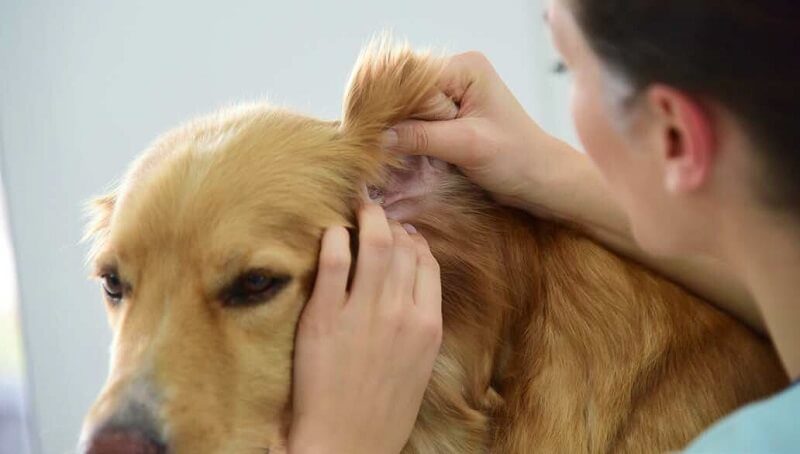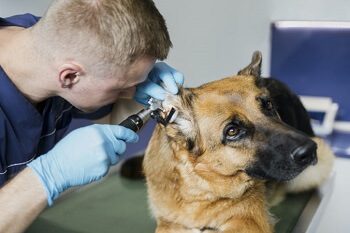
Duck Names – Over 200 Cool And Funny Names For Your Duck
February 6, 2022
Cats vs Dogs: Which Is the Best Pet?
February 7, 2022
Otitis in dogs is quite common and symptoms can be easily noticed, so you will know exactly when to intervene and take measures. Otitis, which can occur at any age, but old dogs are more prone to it, is a chronic inflammation of the ear channel, and this can cause discomfort and even pain to your pet.
In the following, I will tell you what otitis really means for dogs, what are the symptoms, what are the causes of this disease, and how it can be treated.
What is otitis? Types of otitis
As I said, otitis is a chronic inflammation of the ear canal and can be of two types: External and medium.
In the first case, the external ear canal gets inflamed. The external otitis manifests itself in pain, redness, and itching and, untreated, affects the medium ear which, over time, can cause rupture of the eardrum.
In the second type, the inflammation is located in the middle ear.
Are there any breeds of dogs that are prone to otitis?
Yes, even if the otitis can appear in all dogs, regardless of race, size, or age, there are some breeds that are prone to ear inflammation. These are:
Long-ear breeds such as Bass Hound, Spanish Cocker, Golden Retriever, or Labrador Retriever.
Breeds with a lot of hair on the ear canal: Poodle or all kinds of Terriers.
Otitis can affect all dogs, but certain breeds are more prone to this condition, especially breeds with long ears or with a lot of hair on the ear canal like Golden Retriever, Labrador, Spanish Cocker, or Terrier.
Causes of this condition
External and internal otitis can be caused by a long list of factors. The main causes are parasites, food allergies, drug reactions, foreign bodies, hair accumulation, dead skin, or an autoimmune disease.
Other factors that may contribute to the appearance of ear inflammations are Bacterial infections, mixed infections caused by bacteria and fungi, excessive humidity caused by swimming, or inadequate hygiene.
Otitis is rather a common condition in dogs, favored by the anatomical conformation of the ear because the hearing canal is long, “L”-shaped, which facilitates eventual infections.
You might also like our article about atopic dermatitis in dogs.
In addition, dogs sweat a lot in the ear area, and the humidity held by the hair is a good environment for the appearance and development of the micro-organisms, causing infection. For this reason, the breeds of dogs with long ears have a higher risk of having otitis, because their ears are practically always wet. This is why constant ear care is required.
How can you tell that a dog has otitis?
If you notice an unpleasant smell during grooming, the secretions have changed their color and the ear is painful, then it is time to worry and call a veterinarian to advise you of treatment.
The setting up of an appropriate treatment is a priority in order to avoid chronic disease.
The most common symptoms of external and medium otitis you need to be aware of are:
- Pain to the touch
- Shaking of the head
- Constant ear scratching
- Bad smell
- An inclined position of the head
- Refusal to eat
- Occasionally vomiting
During the examination, you could notice:
- Redness
- Inflammation of the canal as well as of the skin inside the ear
A dog who has otitis feels pain and will hardly allow you to touch its ears. This is just a first sign that should alert you. The dog with otitis will tend to over-scratch its ears, will often shake its head, and the ear secretions will change their color and have an unpleasant smell. In rare situations and if the infection has spread, the dog will lose its appetite and it will even vomit.
If you notice one or more of these symptoms, analyze your pet’s ear and if you see that it is inflamed and reddish, go to the veterinarian, who will recommend treatment depending on the stage of the otitis.
How is otitis diagnosed?
Otitis can only be diagnosed by the veterinarian, and in some cases, an X-ray or ear secretion test will be necessary to determine the exact severity of the condition, and depending on these the treatment will be determined.
Treatment and prevention of otitis in dogs
 The treatment of otitis is usually carried out in an outpatient regimen unless the infection has moved into the inner ear.
The treatment of otitis is usually carried out in an outpatient regimen unless the infection has moved into the inner ear.
In most cases, a locally applied treatment, after a complete cleaning of the external ear, is the solution to the problem.
The local treatment may consist of antibacterial, corticosteroids, and antiseptic droplets.
In more severe cases where the presence of infectious organisms has been confirmed, antibiotics and antifungals may be prescribed.
Otitis follow-up treatments involve repeated ear secretion tests and frequent check-ups at the veterinarian.
In any case, it is better to prevent a potential affection than having to treat it. Otitis in dogs can only be prevented by careful and constant hygiene of the ears, taking into account that they have a predisposition to this condition. The hygiene of the ears should be done weekly, but special medications should be used and it is recommended to avoid the usage of ear cleaning sticks. It is also very important to pay attention to symptoms, because, left untreated, the external or medium otitis may lead to deafness or internal otitis.
Grooming your dog’s ears
It is obviously better to prevent than treat; groom your dog regularly and maintain an adequate hygiene at the ear level.
- Grooming is done using special solutions for cleaning your dog’s ears, avoiding the use of ear sticks (although there is a tendency to use them), which only blocks the auditory canal with secretions.
- Correct cleaning means filling the ear with a special cleaning solution. Keep the pavilion under tension to prevent the animal from shaking the head, press it at the base of the ear to pull the dirt to the surface. Then, with a piece of cloth or a cleaning diskette, the auricle is wiped, removing the excess liquid, but penetrating carefully as far as our fingers allow, without insisting. The ideal thing would be to create a common ritual for the dog concerning ear hygiene, without causing it any discomfort, so it won’t avoid or run when we do it
- The grooming should be done weekly when it is easy to see the secretions.
Sometimes pulling or trimming the hair tufts inside or around the ears helps with good ventilation and reduces the humidity.
It is recommended to ask the veterinarian for advice before putting this method into practice, because sometimes excessive hair pulling from these sensitive areas may encourage inflammation. The veterinarian can show you how to perform a correct and adapted hygiene of your pet’s ears, according to their special features.
